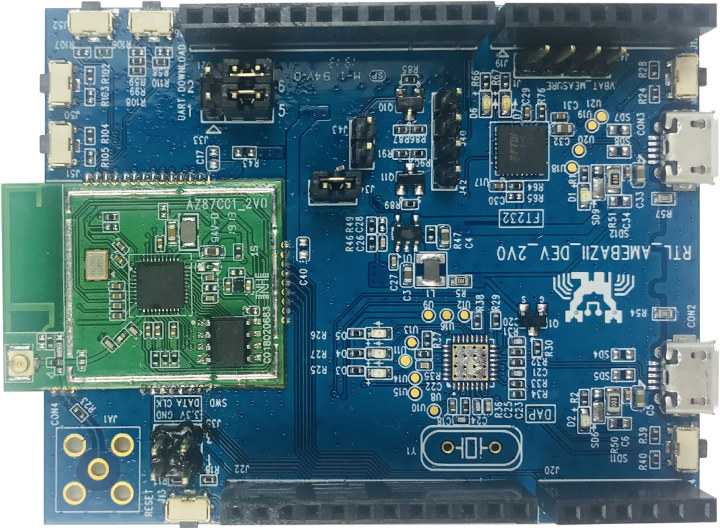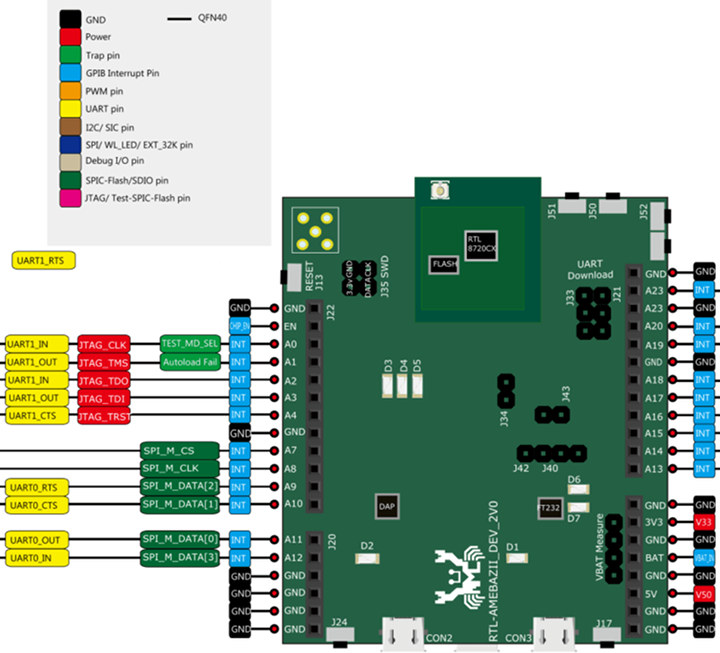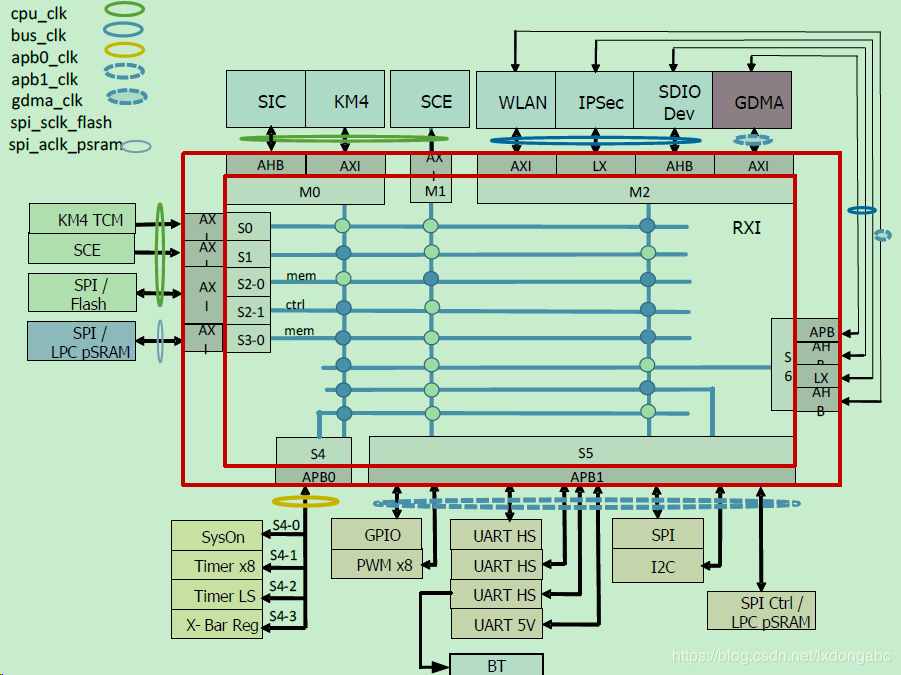In 2016 we discovered Realtek Ameba wireless microcontrollers combining an Arm Cortex-M3 core with WiFi connectivity, and that could potentially become an ESP8266 competitor with modules selling for as low as $2. But the solution never really took off, because it was about the same price as ESP8266, and the latter already had a solid software ecosystem and community.
But RealTek has now introduced a new Ameba Z2 IoT development board powered by RTL8720CM microcontroller featuring an Armv8-M KM4 core clocked at 100 MHz. What’s an Arm KM4 core you may ask? Seeed Studio informed me Arm and RealTek worked together on the KM4 core, so it looks like a custom Armv8-M microcontroller.
Ameba Z2 IoT Development Board

Ameba Z2 (ZII) specifications:
- Wireless MCU – Realtek RTL8720CM single core Armv8-M KM4 core @ 100MHz with 4.2MB internal RAM, WiFi and Bluetooth radios
- Storage – 2MB external flash on module
- Connectivity
- Wi-Fi – 802.11 b/g/n 1×1 Wi-Fi 4 (20/40MHz) with PCB antenna, and u.FL antenna connector
- Bluetooth – BLE 4.2 with optional SIG Mesh
- USB – 2x micro USB ports
- Expansion – Arduino UNO headers with 3x UART including 2 HS-UART and 1 log UART, 1x SPI (Master/Slave), 1x I2C (Master/Slave), 1x SDIO 2.0, 8x PWM, and up to 16x GPIOs
- Misc – 7x buttons, UART download header, 4-pin SWD header, VBat measurement header
- Security – Cryptographic operation, optional TrustZone and secure boot, WiFi WEP, WPA, WPA2 and WPS
Note there aren’t any analog ports, so this won’t be compatible with all Arduino shields.

The RTL8720CM based Ameba Z2 IoT development board is said to run Amazon FreeRTOS. AFAICS, there isn’t any specific documentation for the board yet, and Seeed Studio points to Ameba IoT official website for now, but again no info there.
In case you feel adventurous, you could purchase the board for $23.99 with the full knowledge documentation and software are currently completely missing.
A few more details about RealTek RTL8720CM MCU
A post on CSDN (Chinese language) does provide some more details about the new microcontroller.

The block diagram does provide some insights on how everything is connected internally, and the features list confirm the KM4 core:
- CPU – KM4 core at up to 100 MHz
- Memory/Storage – 384KB internal ROM, 256KB internal SRAM, 4MB pSRAM
- Connectivity – 802.11 b/g/n WiFi 4, Bluetooth Config, Bluetooth Mesh
- Peripherals
- 3x UART
- 1x SPI master up to 20 Mps, 1x SPI slave up to 4 Mbps
- 1x I2C up to 400 Kbps
- 2-channel GDMA (General-purpose DMA controller)
- 16x GPIO
- 8x PWM outputs
- 1x SDIO 2.0 interface
- 1x Watchdog
- Timers – 1x basic timer (32K), 8x advanced timers (40M)
- Debugging – SWD/JTAG
- Security – Secure boot, TrustZone-M (fixed size: 32KB)
- Misc – BOR (Brown-Out Reset) detection; deep sleep wake-pin: 16
- Package – QFN40 (5×5 mm2)
But sadly, we don’t have any information about that KM4 core, so we don’t know what the difference against other Armv8-M microcontrollers such as Arm Cortex-M23 or Cortex-M33. The clear advantage over RealTek Cortex-M3 solutions are the secure bits with support for TrustZone and secure boot.

Jean-Luc started CNX Software in 2010 as a part-time endeavor, before quitting his job as a software engineering manager, and starting to write daily news, and reviews full time later in 2011.
Support CNX Software! Donate via cryptocurrencies, become a Patron on Patreon, or purchase goods on Amazon or Aliexpress





What i need to know in this IOT market : what is the current consumption idle, light sleep and deepsleep and what periph are working for each power mode…
I can find it for esp32 so why i would ever thinking to buy this one? 😀
Not only ESP32 takes over all IoT market completely, but also now I’m thinking of replacing all MCUs that’s been chosen for previous designs.
Now ESP-WROOM-32 module price dropped to around $2.8 and comes with MAC address laser engraving. Developing an application for device pairing application is more easy than ever.
I think the most important behind this success is software support with open-source community driven, not only hardware specifications!
I totally agree. 5 years ago I was thinking about designing AVR- or PIC-based boards to put into my heaters, that would communicate with a central controller via PLC or possibly 433 MHz modules, until I realized that the resulting board would be difficult to design, expensive and too large to fit into the devices. Then I discovered ESP8266 which are cheap, easy to develop, solve all issues. Their level of annoyance is ridiculous compared to other solutions. And now ESP32 is even better for basically the same price and even better software support and more capabilities.
Right now I’d say that if I design a device which needs some form of programmatic control with zero communication and very low power draw, I’d use an AVR, otherwise an ESP32. And combining both might also be an option.
The device above seems to lack any software support for now, so they’ll have to invest a lot to make it attractive. Also the total lack of ADC is not good for embedded devices. It’s quite common to need at least one input, even for approximate measures. My heaters use it with an LDR for easy light detection for example. The precision is not important and being connected to an ADC allows calibration to be done after the device is installed.
>Not only ESP32 takes over all IoT market completely,
haha. And one day they’ll actually maintain LWIP.
Why so stingy on flash size? And why such a big module for a small chip?